Preserving flower petals through drying is a time-honored tradition that allows us to cherish the beauty of blooms beyond their fleeting season. This article provides a comprehensive guide on how to effectively dry flower petals while maintaining their color, shape, and fragrance. We explore various drying methods, the best flowers for drying, and creative ways to use these preserved petals in crafts and décor. By following these expert tips, you can savor the essence of nature’s beauty throughout the year.
Flowers have captivated human hearts for centuries with their vibrant hues and enchanting aromas. One way to extend their beauty is by drying flower petals, a simple yet rewarding process. Dried flower petals find their application in various crafts, potpourri, homemade beauty products, and even culinary delights. To ensure successful petal preservation, we delve into the most effective drying techniques, the ideal flowers for drying, and innovative ways to utilize these preserved petals.
Selecting the Right Flowers for Drying:
Not all flowers are suitable for drying, as some may not retain their color or shape during the process. Opt for flowers with sturdy petals that hold their form well. Some excellent choices include roses, lavender, calendula, marigold, and chamomile. Ensure that the flowers are healthy and free from any signs of wilting or damage before beginning the drying process.
Harvesting Flowers for Drying:
The timing of flower harvesting is crucial for successful drying. Choose to harvest flowers during the morning when their water content is at its lowest, and the blooms are fully open. Use sharp scissors or pruning shears to cut the stems just above a leaf node or bud to encourage further growth.
Drying Methods:
There are several effective techniques for drying flower petals. Each method preserves the flowers in a slightly different way, resulting in varying textures and colors.
a. Air Drying:
Air drying is the simplest and most traditional method for drying flower petals. Gather small bundles of flowers, secure them with rubber bands, and hang them upside down in a dark, dry, and well-ventilated area. This process can take several days to a few weeks, depending on the flower type and humidity levels.
b. Microwave Drying:
For a quicker drying process, consider using a microwave. Place individual petals between two pieces of paper towels and microwave them on low heat in short intervals. Monitor closely to prevent scorching and check for dryness. This method is ideal for small quantities.
c. Silica Gel Drying:
Silica gel is a desiccant that efficiently absorbs moisture from flower petals. Place the petals in an airtight container with silica gel and leave them undisturbed for about a week. This method helps retain the petals’ original color and shape.
d. Pressing:
Flower pressing is ideal for creating flat, preserved petals. Insert petals between layers of absorbent paper and press them between heavy books. This method is perfect for creating decorative pieces, such as framed artwork or greeting cards.
Ensuring Successful Drying:
To achieve the best results, adhere to the following tips during the drying process:
a. Avoid exposing the drying flowers to direct sunlight, as this can cause color fading.
b. Keep an eye on humidity levels in the drying area. Lower humidity facilitates faster and more effective drying.
c. Regularly check the flowers during the drying process and remove any moldy or discolored petals to prevent spoilage.
d. Patience is key! Rushing the drying process may result in subpar results.
Storing Dried Flower Petals:
After the drying process is complete, proper storage is essential to maintain the quality of the petals. Place the dried petals in airtight containers away from direct sunlight and moisture. Adding a silica gel packet to the container can help absorb any residual moisture and prevent mold growth.
Creative Uses for Dried Flower Petals:
Preserved flower petals offer a world of creative opportunities. Here are some exciting ways to incorporate them into your life:
a. Crafting: Use dried flower petals in various crafts, such as creating pressed flower bookmarks, scented sachets, or embellishing handmade candles.
b. Potpourri: Combine dried flower petals with essential oils and herbs to create fragrant potpourri for your home.
c. Beauty Products: Infuse dried petals into homemade soaps, bath salts, or facial scrubs for a touch of natural beauty.
d. Culinary Delights: Some edible flowers, like lavender or rose petals, can be used to garnish desserts, salads, and cocktails, adding a unique touch to your culinary creations.
Conclusion:
Drying flower petals is a delightful and rewarding process that allows us to extend the ephemeral beauty of blooms throughout the year. Whether you choose the traditional air-drying method, opt for microwave or silica gel drying, or prefer the delicate art of pressing, the key lies in selecting the right flowers, proper handling, and patience. Once dried, these petals can be used in numerous creative ways to add charm and a touch of nature’s grace to your surroundings. So, unleash your creativity and start preserving the essence of nature’s beauty with dried flower petals today!


